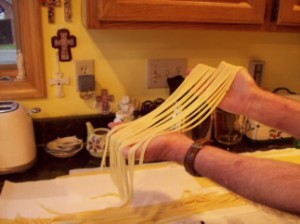by Andrea Kates, Founder, Business Genome™
I love the food industry. It teaches the basic meat and potatoes of consumer demand, even without performing fancy calculations. At its very core, the food industry demonstrates to any business leader some of the most important lessons of the market, partly because people eat three times a day, so there are frequent checks on strategy, and partly because people choose where to eat or how to eat based on how they’re feeling that day or that week. Which makes the entire industry, from high-end restaurants to casual dining to fast food to grocery stores, a great litmus test for the mood of the market.
There’s one classic way to read the food industry that applies to many industries if we stop to think about it very simply. I call it the Waterbed Effect, the phenomenon where you can see where your customers have gone after they’ve left.
The Waterbed Effect is based on the fact that if you push down on one corner of the waterbed, the water shifts to another corner; it generally doesn’t leak out. In math, it’s a closed set.
With certain exceptions, you can look at people’s eating habits and make some observations that describe this type of closed set:
- On average, people eat approximately the same amount of calories per week (despite the supersizing and 4th meal trends).
- If money gets tight, people will trade one option for another. A high end restaurant might lose customers during tight times; low end restaurants might lose customers to grocery stores. However, except in extremely dire times, the customers have not stopped eating.
Therefore, if you are in the food business, it is safe to assume that you don’t have far to look to see where your market has shifted and to interpret the clues about what’s happening with consumer demand and consumer preferences.
Of course, if you’re a restaurant chain, it’s not that easy to turn on a dime and respond immediately to the changing market. However, whether you’re in the food business or any other business, it’s important to read the signs of the Waterbed Effect to learn about what matters most to your bread-and-butter customers and change as quickly as you can.
Many times we don’t realize that we’re living in a waterbed. We can blame slumps in sales on a softening economy. We sometimes even make the leap (in non-food industries) directly from “people have stopped buying certificates of deposit” to “people have stopped saving money.” But, it’s critical to look at the closed set of options and see which other players are benefiting when we’re at a loss.
Looking at the clues, we can uncover what is really happening, and we can adapt to the market shifts.
In this dreadful economy, it’s sometimes too depressing to study the details of where dollars are being spent and what’s being traded for what. Common sense tells us what we see in the numbers at first glance: during tough times, people trade food away from home for food at home.
But, digging deeper into food trends, there are some clues about what goes up when the tide goes down. For example, the American Italian Pasta Co reported a 5 percent rise in sales last year:
 It’s like a certain number of people rediscovered pasta, according to the CEO of New World Pasta, maker of Ronzoni, American Beauty and Creamette. They reported that this rise in pasta sales reversed the former downward trend, caused partly by the high-protein diets.
It’s like a certain number of people rediscovered pasta, according to the CEO of New World Pasta, maker of Ronzoni, American Beauty and Creamette. They reported that this rise in pasta sales reversed the former downward trend, caused partly by the high-protein diets.
Or, in Waterbed terms, push down on beef, push up on pasta.
How would the Waterbed Effect predict chocolate sales? Staples up? Luxuries like chocolate down? Not so. Market Watch reported, Hershey’s fourth-quarter net income rose by 50% as sales edged up and its chocolate business weathered the economic downturn better than many. 
So, what lessons to learn from those results? Dig deeper and discover what went down as Hershey’s was riding high.
Market Watch explained: “Pressure in the high-end chocolate market may benefit Hershey, which sells more less-expensive sweets.”
It’s easy to jump to the wrong conclusions, or to forget to read the simple signs of change in a Waterbed world. But, training yourself to watch the water shift and interpret the implications will provide valuable lessons about how to tap into the trends and regain customer loyalty.







